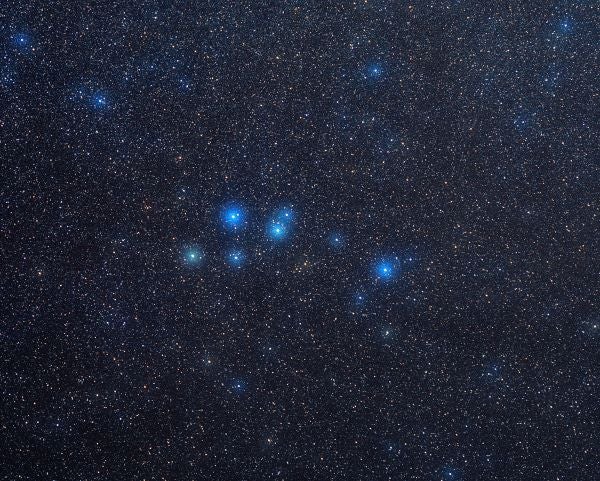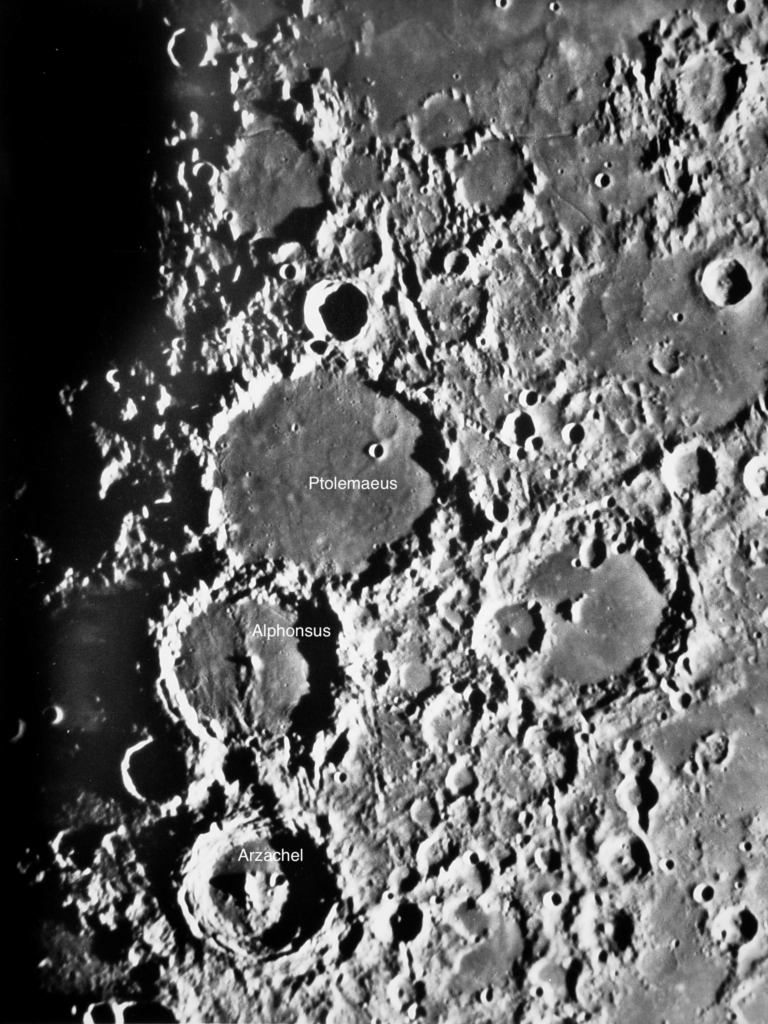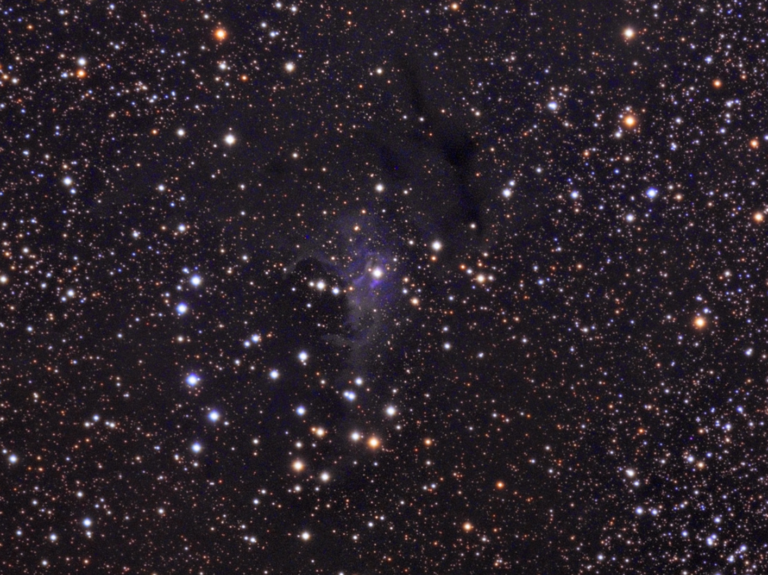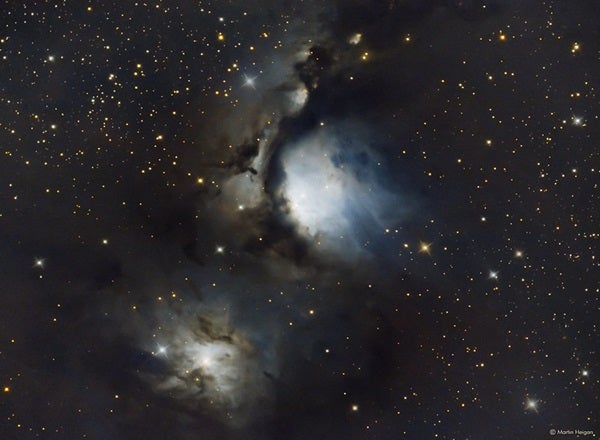
Friday, March 17
Mercury reaches superior conjunction at 7 A.M. EDT. The small planet will return after sunset near the end of March.
The waning Moon means evening skies are completely clear for stargazing. After dark, you’ll have some time to enjoy the rich treasures of the constellations Orion and Taurus, slowly setting in the west. Start with Taurus, the current home of magnitude 0.7 Mars, situated just above a line drawn between Alheka and Elnath, which mark the tips of the Bull’s horns. The Red Planet displays a 7″-wide disk whose features might be tricky to discern by eye, though high-speed video capture may do the trick. Around 10 P.M. EDT, the dark smudge of Sinus Meridiani is near the center of the disk, just as Syrtis Major is rotating off and the lighter-colored Tharsis region is rotating on.
Some 25° below Mars is the Pleiades star cluster, easy to spot even with the naked eye. This grouping is often called the Seven Sisters for a reason — how many of its stars can you see? Try looking with averted vision, turning your gaze off to the side and glimpsing the cluster out of the corner of your eye.
Just east of Taurus in the sky is Orion the Hunter, whose great nebula M42 is one of observers’ favorite targets to enjoy. This large star-forming region glows a soft green when viewed through a telescope and surrounds the four bright stars of the Trapezium in its center. These young, hot suns are in the process of blowing away the cloud that birthed them, leaving behind a darker void in their immediate vicinity — can you see it through your scope?
Sunrise: 7:09 A.M.
Sunset: 7:09 P.M.
Moonrise: 4:59 A.M.
Moonset: 2:15 P.M.
Moon Phase: Waning crescent (22%)
*Times for sunrise, sunset, moonrise, and moonset are given in local time from 40° N 90° W. The Moon’s illumination is given at 12 P.M. local time from the same location.
Saturday, March 18
It’s prime Messier marathon time! With a slim crescent Moon present for only a short time before sunrise, this is the best weekend of the year to attempt catching a glimpse of all 109 Messier objects in a single overnight sprint. According to amateur astronomer Tom Polakis, skywatchers located between 7° and 33° north latitude have the potential to score every object this weekend. That range is calculated by determining whether globular cluster M30 can be spotted just before sunrise, as well as open cluster M52’s altitude above the southern horizon.
If you’re up for the challenge, make sure you’re ready with large binoculars or a small scope shortly before sunset. However, don’t ever begin using any optical equipment until the Sun has fully set from your observing site, which is heavily location dependent and may be at a time slightly different from that given below. Similarly, make sure to put down your optics before sunrise is set to begin from your location.
For a tried-and-true list of Messier marathon targets, check out the late Don Machholz’s suggested search sequence. And if you aren’t up for a full marathon, former Astronomy columnist Glenn Chaple has a great short list of easy Messier objects to whet your appetite, including M35, M42, M44, M45, M81, and M82.
If weather or sleep deprivation prevents you from running the full marathon this weekend, don’t worry — next weekend provides a backup opportunity for most observers.
Sunrise: 7:07 A.M.
Sunset: 7:10 P.M.
Moonrise: 5:43 A.M.
Moonset: 3:34 P.M.
Moon Phase: Waning crescent (13%)
Sunday, March 19
Whether you’re still awake at the tail end of your Messier marathon or simply an early riser, there’s another challenge to try this morning in the predawn sky. About half an hour before sunrise, see if you can spot Saturn and the delicate crescent Moon rising together in the east.
Our satellite is less than 10 percent illuminated and a mere 2° high 30 minutes before sunrise. Saturn sits just less than 5.5° to its upper left (north-northeast), glowing softly at magnitude 0.9 and 4.5° high. You’ll likely need binoculars or a telescope to pick out the ringed planet against the quickly brightening sky. Its disk stretches about 15″ across, while its rings span more than twice that distance. Again, make sure to stop using any opticals several minutes before the Sun is set to rise from your location.
A few hours later, the Moon will pass 4° due south of Saturn at 11 A.M. EDT. Our satellite also reaches perigee, the closest point to Earth in its orbit, at 11:12 A.M. EDT. At that time, Luna will sit 225,369 miles (362,696 kilometers) away.
Sunrise: 7:05 A.M.
Sunset: 7:11 P.M.
Moonrise: 6:18 A.M.
Moonset: 4:52 P.M.
Moon Phase: Waning crescent (6%)
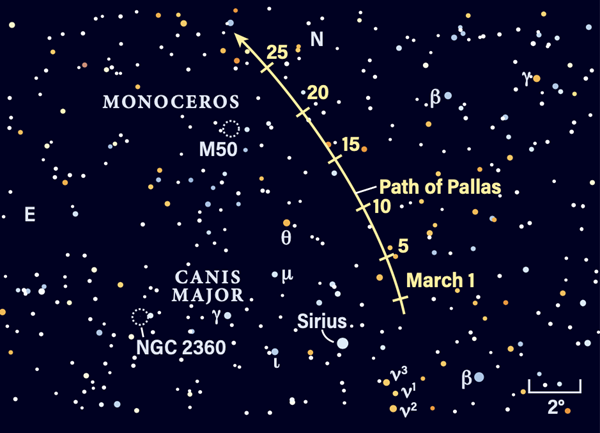
Monday, March 20
The vernal equinox occurs at 5:24 P.M. EDT, marking the first day of spring in the Northern Hemisphere. It is also the day when the Sun sits exactly above Earth’s equator.
This evening, asteroid 2 Pallas sits west-northwest of open star cluster M50 in Monoceros. If you’re not overly familiar with the constellation, that’s okay — instead, just find Sirius, the brightest star in the sky and the nose of Canis Major. Pallas and M50 are some 9° north-northeast of Sirius, appearing to sit directly above it in the south.
Let’s start with Pallas: Glowing at magnitude 8.2, you’ll find the large main-belt world just 4.3° north of 4th-magnitude Theta (θ) Canis Majoris. M50 lies just under 3° to Pallas’ east. This is a 6th-magnitude open cluster that spans some 16′; many observers comment that it has a vaguely heart-shaped appearance. And there’s more: About 3.5° to M50’s southeast is NGC 2353, a 7th-magnitude open cluster that’s a bit wider, some 20′ across.
Any of these targets will pop out nicely with just binoculars, or you can opt for a telescope to bring out more stars in the two clusters.
Sunrise: 7:04 A.M.
Sunset: 7:12 P.M.
Moonrise: 6:48 A.M.
Moonset: 6:09 P.M.
Moon Phase: Waning crescent (2%)
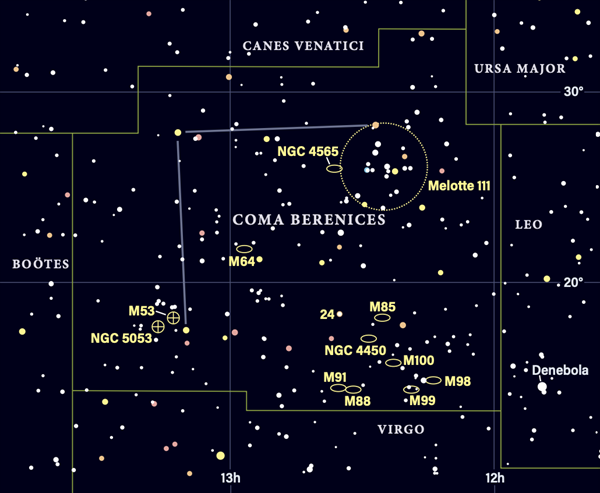
Tuesday, March 21
Dwarf planet 1 Ceres reaches opposition at 4 A.M. EDT. Glowing at magnitude 7, the largest body in the main belt sits tonight in southern Coma Berenices, amid plentiful deep-sky objects readily visible with no Moon in the sky. That’s because New Moon also occurs today at 1:23 P.M. EDT.
Coma Berenices is already rising at sunset; give it a few hours for the sky to grow dark and this region to climb well above the turbulent atmosphere near the ground. Then, pull out binoculars or a telescope to first find Ceres, which sits some 10.3° west-southwest of Diadem, Coma Berenices’ 4th-magnitude alpha star. The main-belt world is located close to the magnitude 11.6 galaxy NGC 4421, which lies some 4′ southwest. Slightly brighter magnitude 11.1 NGC 4419 is just 0.5° to Ceres’ south-southwest.
But better yet, Ceres is encircled by several galaxies ripe for the picking in the dark skies. Just 1° west-northwest is M100, while within 2° to Ceres’ southwest are M98 and M99. Some 1.5° southeast sit M88 and M91, while 1.5° north-northeast is NGC 4450. Check out the star chart above and read through our recent article on how to observe deep-sky gems in Coma Berenices for more details on these and many other targets!
Sunrise: 7:02 A.M.
Sunset: 7:13 P.M.
Moonrise: 7:15 A.M.
Moonset: 7:24 P.M.
Moon Phase: New
Wednesday, March 22
The Moon passes 0.5° south of Jupiter at 4 P.M. EDT. Both are close to the Sun and set soon after our star, but observers up for a challenge can give finding them a try about 30 minutes after sunset, when the pair is roughly 8° high in the west.
Jupiter should be relatively easy to spot, as it’s a bright magnitude –2.1. Don’t confuse it for brighter Venus (magnitude –4), which lies higher above the western horizon, still some 30° up half an hour after the Sun disappears.
Once you’ve found Jupiter, the real challenge begins: The Moon is just over 1 day old and a mere 2 percent lit as sunrise begins to creep over its eastern limb. Look for it just over 1.5° northeast of Jupiter (to the planet’s upper left) as they sink toward the horizon together, setting about 75 minutes after the Sun. Longtime Astronomy columnist Stephen James O’Meara has some excellent tips for spotting a spectacularly thin lunar crescent with the naked eye, including starting with binoculars and, once you’ve gotten a fix, sliding them away.
Sunrise: 7:00 A.M.
Sunset: 7:14 P.M.
Moonrise: 7:40 A.M.
Moonset: 8:36 P.M.
Moon Phase: Waxing crescent (1%)
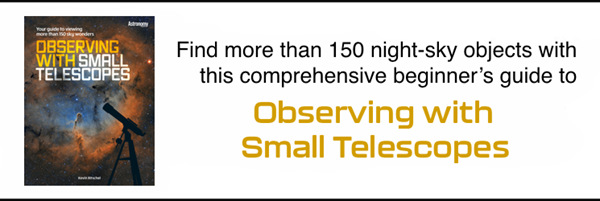
Thursday, March 23
With the Moon still a meager 7-percent-lit crescent already sinking in the west at sunset, tonight is an excellent opportunity to watch for both the appearance of the zodiacal light and the sporadic meteors that sometimes light up the sky.
Let’s start with the zodiacal light, which is the glow of sunlight scattering off debris left by countless comets as they traveled through the inner solar system. This cone-shaped pillar of light appears after sunset at this time of year, once the sky has grown fully dark. It’s hard to see unless you’re looking from a dark location free of streetlights or bright city lights to the west. If you can, try to get to a site with a little elevation above the surrounding area as well, as this will further help your search. The zodiacal light generally becomes visible about an hour after sunset and remains in the west for an hour or so more, slowly setting with the constellations in that region. Its base is widest and it grows fainter and comes to a rounded point as it arcs up through Aries and Taurus.
If your observing site isn’t ideal for spotting the zodiacal light, you can instead scan the skies regularly for sporadic meteors, which can occur at any time of year and don’t require an upcoming shower. On an average spring night, you might see two to four meteors per hour. You’re most likely to see the streak of a random shooting star when your eyes are dark adapted and your observing site is as dark as possible. Simply scan slowly overhead and keep your eyes on the sky, and you might just see one of these random streaks of light overhead.
Sunrise: 6:59 A.M.
Sunset: 7:15 P.M.
Moonrise: 8:05 A.M.
Moonset: 9:49 P.M.
Moon Phase: Waxing crescent (5%)
Friday, March 24
The Moon passes 0.1° south of Venus at 6 A.M. EDT, then continues trundling along the ecliptic to pass 1.5° north of Uranus at 9 P.M. EDT. An hour after sunset, you can catch all three in Aries, still well above the western horizon.
Venus is a bright, magnitude –4 evening star in southwestern Aries, located roughly halfway between magnitude 2.5 Menkar in Cetus and magnitude 2 Hamal in the Ram. Just less than 7° above the bright inner planet is the Moon, now a 14-percent-lit waxing crescent with more of its eastern limb illuminated. Uranus, at magnitude 5.9, will likely require binoculars or a telescope for all but the sharpest-eyed observers in the darkest locations. Look for the distant ice giant just 1.2° south of the crescent Moon.
Through a telescope, Uranus appears as a “flat,” 3″-wide, grayish point of light. Can you differentiate its disklike appearance from that of any nearby, pointlike background stars? Slide down to Venus for something different: The inferior planet not only appears much larger at 14″ across, but also shows off an 80-percent-lit gibbous phase.
Sunrise: 6:57 A.M.
Sunset: 7:17 P.M.
Moonrise: 8:32 A.M.
Moonset: 10:59 P.M.
Moon Phase: Waxing crescent (11%)







